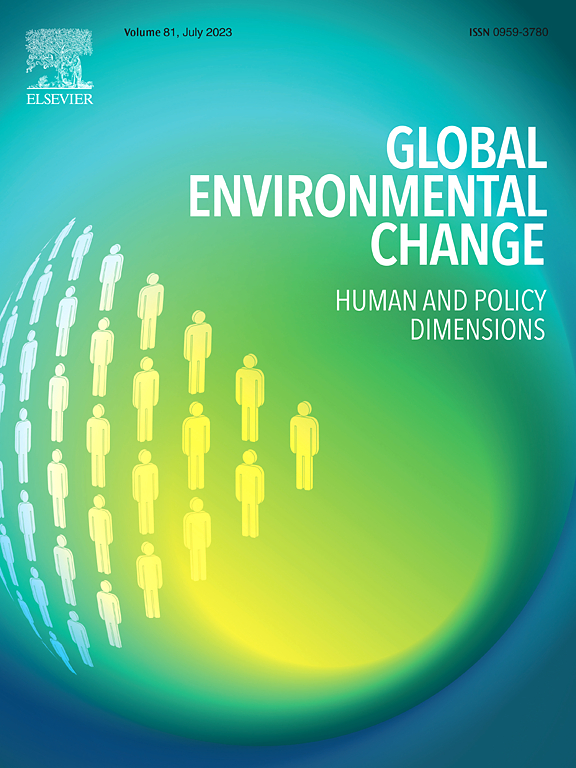Measuring the contribution of nature-based solutions beyond climate adaptation in cities
IF 9.1
1区 环境科学与生态学
Q1 ENVIRONMENTAL SCIENCES
引用次数: 0
Abstract
Measuring the contribution of urban nature-based solutions (NbS) to climate change adaptation is an essential, though complex, step towards understanding who benefits from them, as well as when, where, how and why. However, urban NbS are also framed as being able to meet multiple objectives relating to biodiversity conservation as well as associated social challenges. The complexity of addressing multiple challenges, combined with conflicting visions of what climate adaptation means at the local level, further burdens the identification of clear and relevant goals, processes and information to track progress (i.e. contributions) towards urban adaptation. To explore and question how current on-the-ground practices address this complexity, we analysed a global dataset of indicators (n = 750 indicators) from 74 NbS projects in 61 cities across 40 countries based on an assessment of the literature regarding information and processes used for evaluating urban NbS for adaptation. This was combined with interviews with local actors who evaluate these NbS projects (n = 15). Our results indicate that current urban NbS projects do not appear to balance climate adaptation with other goals, nor do they uniformly conform to prevailing technical standards of quality of traditional monitoring, evaluation and learning processes. Currently NbS projects tend to primarily prioritise shorter-term high-quality ecological indicators, mostly related to biodiversity, while generally other longer-term social and technical indicators lack quality despite capturing a diversity of potential medium- to long-term contributions of NbS. Various political and social factors that influence the way urban NbS to adaptation are evaluated typically go beyond evaluation purposes and range from using indicators to promote NbS as cost-effective solutions or particular political agendas. The diversity of what makes good information and processes to measure contributions to urban adaptation bolsters calls for establishing processes for flexible, commonly agreed-upon guiding principles. We suggest locally grounded recommendations to help identify fit-for-purpose information and processes to evaluate the potential of urban NbS to address interconnected climate, biodiversity, and societal challenges.
衡量基于自然的解决方案在城市气候适应之外的贡献
衡量城市自然解决方案(NbS)对适应气候变化的贡献是了解谁从中受益以及何时、何地、如何和为何受益的重要一步,尽管这一步非常复杂。然而,城市自然解决方案也被认为能够满足与生物多样性保护相关的多重目标以及相关的社会挑战。应对多重挑战的复杂性,再加上对气候适应在地方层面的意义的不同看法,进一步加重了确定明确的相关目标、流程和信息以跟踪城市适应进展(即贡献)的负担。为了探索和质疑当前的实地实践如何解决这一复杂问题,我们分析了全球指标数据集(n = 750 个指标),这些指标来自 40 个国家 61 个城市的 74 个国家适应性试点项目,并基于对用于评估城市国家适应性试点项目的信息和流程的文献评估。此外,我们还采访了评估这些NbS项目的当地参与者(n = 15)。我们的结果表明,目前的城市非营利性社会项目似乎并没有平衡气候适应与其他目标,也没有统一符合传统监测、评估和学习过程质量的普遍技术标准。目前,净减排项目倾向于优先考虑较短期的高质量生态指标,主要是与生物多样性相关的指标,而其他较长期的社会和技术指标一般都缺乏质量,尽管它们捕捉到了净减排潜在的中长期贡献的多样性。影响城市非核心资源适应评估方式的各种政治和社会因素通常超出了评估目的,包括利用指标将非核心资源作为具有成本效益的解决方案或特定政治议程进行推广。由于衡量城市适应贡献的信息和流程多种多样,因此需要制定灵活、共同认可的指导原则。我们提出了一些立足于本地的建议,以帮助确定符合目的的信息和流程,从而评估城市非传统服务在应对相互关联的气候、生物多样性和社会挑战方面的潜力。
本文章由计算机程序翻译,如有差异,请以英文原文为准。
求助全文
约1分钟内获得全文
求助全文
来源期刊

Global Environmental Change
环境科学-环境科学
CiteScore
18.20
自引率
2.20%
发文量
146
审稿时长
12 months
期刊介绍:
Global Environmental Change is a prestigious international journal that publishes articles of high quality, both theoretically and empirically rigorous. The journal aims to contribute to the understanding of global environmental change from the perspectives of human and policy dimensions. Specifically, it considers global environmental change as the result of processes occurring at the local level, but with wide-ranging impacts on various spatial, temporal, and socio-political scales.
In terms of content, the journal seeks articles with a strong social science component. This includes research that examines the societal drivers and consequences of environmental change, as well as social and policy processes that aim to address these challenges. While the journal covers a broad range of topics, including biodiversity and ecosystem services, climate, coasts, food systems, land use and land cover, oceans, urban areas, and water resources, it also welcomes contributions that investigate the drivers, consequences, and management of other areas affected by environmental change.
Overall, Global Environmental Change encourages research that deepens our understanding of the complex interactions between human activities and the environment, with the goal of informing policy and decision-making.
 求助内容:
求助内容: 应助结果提醒方式:
应助结果提醒方式:


